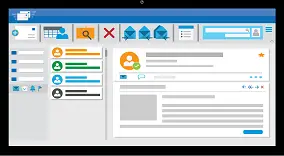There will be points in the next correspondence session that you will need to address more than one person for various purposes such as business, casual, and so on. When you address an email to multiple recipients either your partner or another person, you need to know how to be courteous and professional.
If you are addressing more than one person in a formal letter, you could use “Dear Sirs”. On the contrary, you can simply use “Hi” if it is informal. “Hi” addresses either one person or many people. It is the same as “you”, which can also refer to one single person or many people.
Keep in mind that the methods that I mentioned above will not work if you have no idea of the names of your recipients. But if you do know the names of the other parties who will receive your messages, you will need to mention their names.
For instance, you could use the usual “Dear Mr./Mrs.”. If your recipients are larger groups, you could refer to each recipient as a part of the whole. For instance, “Dear Party Members”, for instance. The polite phrase alone already represents the courteous address to the larger group of recipients.
You can also refer to each recipient if the number of people is still manageable for your text body space.
Here are the tips that you would like to consider when you address your email to multiple recipients such as your acquaintances, partners, or strangers:
1. Using Dear is never wrong
Using Dear is indeed the right approach. On the other side, using Hi for a formal purpose is considered impolite.
If you are addressing a group of people in an informal way, you could use ” Hi, Hi All, Hi Team, Hi Everyone, and so on.
If you are writing a more formal email, you will want to use formal greetings like Dear Co-workers, Dear Colleagues, and so on. You can also use “Dear Sirs” as well. You will refer to one person or many, so it is much safer to address them with this method.
Using “Dear All” is not wrong at all. In fact, it is one of the standard salutations for the correspondence lessons in the secretarial formal courses. Secretaries and other jobs relevant to correspondence have been using this formula for decades. Therefore, it can be safe to use “Dear” to address the other person in formal mail politely.
If you are contacting your lecturer, professor, higher-ups, or someone you respect a lot, using “Dear” is also appropriate in the formal letter. The tricky part is when you address a female recipient professionally. Because you must use the accepted method of addressing females without indicating their marital status, you must know whether she is married or not. If you knew their professional status, then it would have been much easier since you could have replaced Mrs./Ms. with a doctor, a professor, or else. But if you’ve known her marital status, you can go ahead and use Mrs/Ms. Proper addressing will help you to avoid any hassle or problems when emailing professionally.
Proper addressing can help to avoid misunderstanding when sending emails to your recipients. The opening salutation can make or break your entire message. Addressing an email to one single person could be easy. But it can be a bit trickier when sending messages to three or more people at once. It is important to manage the salutations carefully to make sure that the messages are taken with courtesy and appropriateness.
2. The salutation is for all
Your recipients could be three, four, or more people. If you have the same specific content for them in the email, it is not wrong to create an equal salutation for them. You could use Dear Mr. Jon, Mr. Doe, and Mr. Smith, for instance. That will also depend on the level of formality of the occasions.
It is important to know the gender of each recipient. You won’t want to take the risk of ruining your project by wrongly addressing it. If you are not sure about your recipients’ genders, you could safely go with “Dear, all” and similar salutations. Also, you will want to maintain the nuance of the email. Whether it is formal or casual, make sure to pinpoint the right person with the right address.
3. Sometimes you can’t just bring them all at once
When it comes to business or in formal situations, you might see different kinds of recipients with different levels of formality. If those recipients have different levels of formality, it is much better to separate the emails for different people rather than gather them all at once. Obviously, you can send a message to your colleagues and use the same content for the other recipient, such as your lecturer.
4. Don’t forget common courtesy
Before sending the letter, consider if you need to involve the three recipients in a single conversation. If you invite three people to one party, it is best to send a single message; however, if you organize a party and three friends help you, it may be better to send three separate messages, each with only the necessary information. If you must send only one message, greet the three recipients as usual, but do everything you can to stress whatever portions of the letter will be crucial for everyone. If you must send only one message, please address it to the three recipients in your welcome.
5. If possible, use their names
Since you are addressing multiple people, there might be a position when you are not able to address all of them at once. It is no way to fill the entire page with the name of each person you address. But you can actually simply replace them with “friends”, “team”, “colleagues”, or other replacements. For instance, if you are addressing a team of developers, then you will address them as a team. You could use the name of the team leader. For instance, a formal letter can be addressed to “Mr. Scott and team“.









